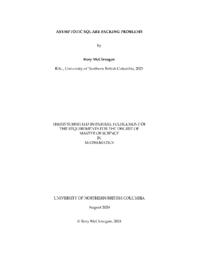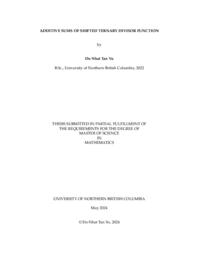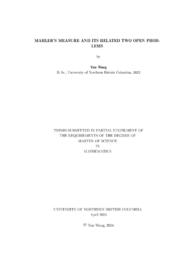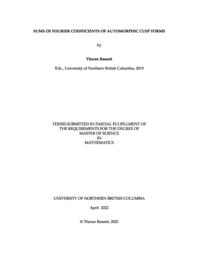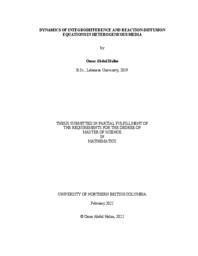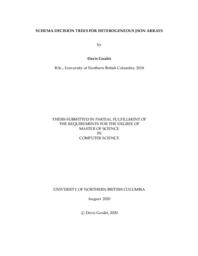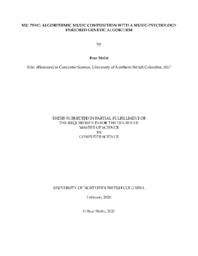Hamieh, Alia
Person Preferred Name
Alia Hamieh
Related Works
Content type
Digital Document
Origin Information
Content type
Digital Document
Description / Synopsis
The main achievement of the thesis is the proof that 1+√17 is not a Mahler measure of an algebraic number. This answers a question of A. Schinzel posted in [6] in 2004. We also show that, theoretically, there exists an algorithm to reduce the shortness of a polynomial without changing its Mahler measure, a problem considered in [5] by J. McKee and C. Smyth. However the number of computations required makes this algorithm infeasible.
Origin Information
Content type
Digital Document
Description / Synopsis
Quantum computing is a rapidly advancing field of computer science that is increasingly becoming more practical. With these devices becoming more realistic, frameworks are needed by which the hardware resources, both quantum and classical, of quantum computers can be utilized more efficiently. This research aims to fill gaps in the research examining the effectiveness of hardware scheduling on the current generation of quantum computers. A hardware scheduling strategy is implemented using the A* search algorithm for routing qubits to conform with hardware limitations, and this algorithm is tested against a wide variety of quantum programs and devices. The effectiveness of the scheduler is determined through analysis of metrics obtained from the scheduling process. This particular scheduler proved to be effective for most of the tested algorithms and efficient for some, making it useful for general purposes, though some potential sources of improvement could increase the number of algorithms it is efficient for.
Origin Information
Content type
Digital Document
Description / Synopsis
No abstract available.
Origin Information
Content type
Digital Document
Description / Synopsis
In this work, we study two different models that appear in population dynamics. The first problem is concerned with an integral equation that models discrete time dynamics of a population in a patchy landscape. The patches in the domain are reflected through the discontinuity of the kernel of the integral operator at a finite number of points in the whole domain. We prove the existence and uniqueness of a stationary state under certain assumptions on the principal eigenvalue of the linearized integral operator and the growth term as well. We also derive criteria under which the population undergoes extinction (in which case the stationary solution is 0 everywhere). In the second problem we consider a reaction-diffusion model with a drift term in a bounded domain. Given a time T, we prove the existence and uniqueness of an initial datum that maximizes the total mass [equation] in the presence of an advection term. In a population dynamics context, this optimal initial datum can be understood as the best distribution of the initial population that leads to a maximal the total population at a prefixed time T. We also compare the total masses at a time T in two cases: depending on whether an advection term is present in the medium or not. We prove that the presence of a large enough advection enhances the total mass.
Origin Information
Content type
Digital Document
Description / Synopsis
Due to the popularity of the JavaScript Object Notation (JSON), a need has arisen for the creation of schema documents for the purpose of validating the content of other JSON documents. Existing automatic schema generation tools, however, have not adequately considered the scenario of an array of JSON objects with different types of structures. These tools work off the assumption that all objects have the same structure, and thus, only generate a single schema combining them together. To address this problem, this thesis looks to improve upon schema generation for heterogeneous JSON arrays. We develop an algorithm to determine a set of keys that identifies what type of structure each element has. These keys are then used as the basis for a schema decision tree. The objective of this tree is to help in the validation process by allowing each element to be compared against a single, more tailored, schema.
Origin Information
Content type
Digital Document
Description / Synopsis
Recent advancement of artificial intelligence (AI) techniques have impacted the field of algorithmic music composition, and that has been evidenced by live concert performances wherein the audience reportedly often could not tell whether music was composed by machine or by human. Among the various AI techniques, genetic algorithms dominate the field due to their suitability for both creativity and optimization. Many attempts have been made to incorporate rules from traditional music theory to design and automate genetic algorithms. Another popular approach is to incorporate statistical or mathematical measures of fitness. However, these rules and measures are rarely tested for their validity. This thesis is aimed at addressing the above limitation and hence paving the way to advance the field towards composing human-quality music. The basic idea is to look beyond this constrained set of traditional music rules and statistical/mathematical methods towards a more concrete foundation. We look to a field at the intersection of musicology and psychology, referred to as music-psychology. To demonstrate our proposed approach, we implemented a genetic algorithm exclusively using rules found in music-psychology. An online survey was conducted testing the quality of our algorithm’s output compositions. Moreover, algorithm performance was analyzed by experimental study. The initial results are encouraging and warrant further research. The societal implications of our work and other research in the field are also discussed.
Origin Information


